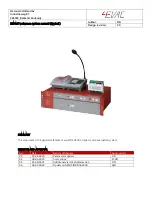
SB6100 Industrial Shock Block
Page 12
Rev. 1-I-071520
contactor if any of the following conditions are present:
•
Input 3 is not connected
•
Input 3 fuse is open
•
Supply ground is open
After the SB6100 input supply connection is corrected,
the SB6100 will automatically close the contactor if no
other fault conditions are detected.
NOTE:
SB6100 electronics are supplied from input
phases 1 and 2. If either phase is not connected, the unit
will remain off with the contactor open.
NOTE:
The input connection is checked for correct
wiring only during power-up. Accordingly, if Input 3 or
the supply ground opens during normal operation, the
SB6100 will not detect an input supply connection
problem.
3.5 Undervoltage and Chatter Detection
The input voltage is always checked before the
contactor is closed. If an input undervoltage condition is
detected, the contactor will remain open and the red INP
LED will flash every second. The control circuit will
continuously check the input voltage and will close the
contactor when the input voltage is within acceptable
limits.
Undervoltage detection is provided to prolong the
lifetime of the contactor by preventing contactor chatter.
Contactor chatter occurs when the voltage applied to the
control coil is marginally lower than the minimum pull-in
voltage.
3.6 Contactor Monitoring
The SB6100 continuously monitors the state of the
contactor. If an incorrect state is detected, the FLT LED
will flash every second, the contactor will open and will
remain open until supply voltage to the unit is cycled.
This condition should never be encountered during normal
operation.
The SB6100 should be used within the specifications
listed in Section 7 to ensure correct operation.
NOTE:
At room temperature, the minimum contactor
pull-in voltage is approximately 80% of the nominal
voltage. At higher temperatures, the minimum pull-in
voltage is higher than 80% of the nominal voltage.
3.7 Ground-Fault Detection
The red Fault (FLT) LED indicates a ground-fault trip.
The SB6100 will remain tripped until the RESET/START
button is pressed or supply voltage is cycled. See Section
3.1.2.
3.8 Momentary Power Loss and Brown-Out
Detection
When supply voltage to the SB6100 is removed, the
contactor will open and the green PWR and EN LEDs will
turn off. For a short supply outage of approximately 20
seconds, the SB6100 will remain powered-up and retain
its state prior to the outage (either energized or tripped).
For longer supply outages, the SB6100 will power-up in
an untripped state.
In the case of a brown-out condition where the input
voltage dips too low, the contactor will open, and the red
FLT LED will flash every second. The SB6100 will
remain in a tripped state until RESET/START is pressed.
Before pressing RESET/START, ensure the input voltage
is within the acceptable range.
NOTE:
At 25°C (77°F), the contactor drop-out voltage
level is approximately 60% of the nominal supply voltage.
At higher temperatures, the contactor drop-out voltage is
higher than 60% of the nominal voltage.
3.9 Load-Ground-Connection Monitor
The Load-Ground-Connection Monitor (GC) LED
indicates that the load ground is open. If the load ground
connection is not connected during power-up or becomes
disconnected during normal operation, the GC LED will
turn ON and the contactor will open.
The SB6100 continuously monitors the load ground
and will automatically close the contactor if the load-
ground connection is restored.
NOTE:
Load-ground-connection monitoring is only
required for GFCI Class C and Class D models as per UL
943C. Refer to Section 4.3 for a description of the UL
943C load-ground monitor requirements. For EGFPD and
GFCI Class A models, load-ground-connection
monitoring is optional.
3.10 UL 943 Self-Test and UL 1998 Requirements
The 2015 revision to the UL 943 standard includes a
self-test requirement to verify a GFCIs ability to respond
to a ground fault. All SB6100 options (revision 01 or
newer) include an automatic self-test feature. If a problem
is detected, the SB6100 will trip. A Self-Test Failure will
be indicated by a unique LED pattern as shown in Fig. 12.
A self-test is initiated a few seconds after power-up, a
few seconds after the contactor is closed, and hourly
during normal operation. A self-test may be indicated by
a brief flash of one or several ground-leakage LEDs.
In addition to the automatic self-test, a monthly manual
test is also recommended.
Compliance to the UL 1998 Software in Programmable
Components standard is also included.
FIGURE 12. Self-Test Failure Indication.
Содержание Industrial Shock Block SB6100
Страница 7: ...SB6100 Industrial Shock Block Page 5 Rev 1 I 071520 FIGURE 3 SB6100 311 0 Enclosed Model Lid not shown...
Страница 18: ...SB6100 Industrial Shock Block Page 16 Rev 1 I 071520 FIGURE 16 AC6000 CART 00 Outline...
Страница 19: ...SB6100 Industrial Shock Block Page 17 Rev 1 I 071520 FIGURE 17 AC6000 MNT 00 Outline...
Страница 20: ...SB6100 Industrial Shock Block Page 18 Rev 1 I 071520 FIGURE 18 AC6000 CART with SB6100 Installed...











































